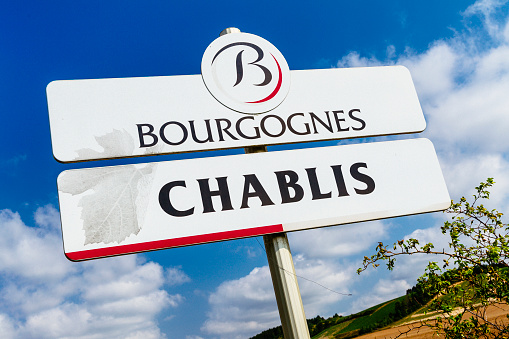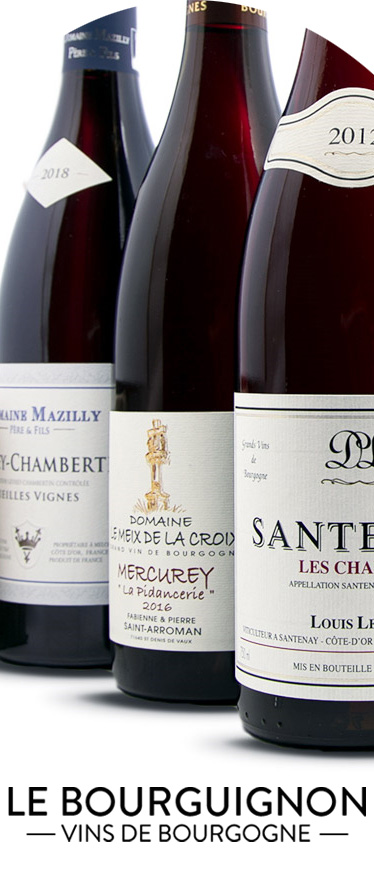Chablis has known for a century a very good reputation in the world, almost synonymous with "great dry white wine"!
The first and great growths of Chablis are part of the Chablis vineyard off the Coast of Gold in the department of Yonne (89), they are appellations of controlled origin of Burgundy.
During the elaboration of this wine, the Chardonnay grape variety, locally called the Beaunois, is used exclusively. The wines produced are white, clear, fragrant and lively.
In Burgundy, the different plots determine a regional, communal, premier cru and grand cru appellation according to their geographical location.
Hierarchy of appellations in Burgundy
In order to better navigate, its 83 appellations have been divided into 4 levels: 
- Grands Cru appellations
- Premiers cru appellations
- Communal appellations (villages)
- Regional names (sometimes called "generic" or "sub-regional")
Here is the hierarchy of appellations for Chablis
- Chablis grand cru + name of the original climate
- Chablis premier cru + name of the original climate
- Chablis
- Small Chablis
|
The term climate refers to the parcels of land in Burgundy. This word takes into account the know-how of the winegrowers, the geological characteristics, the particular exposures and each plot is precisely delimited. |
AOC Chablis Grand Cru
The Chablis grand cru appellation was created in 1938, it covers 103 hectares of vines, located on the right bank of the Serein.
Today the Chablis Grand Cru appellation is divided into seven climates grouped on the same hill:
- Blanchot (or Blanchots)
- Bougros
- Frogs
- The Clos
- The Preuses
- Valmur
- Vaudésir
=> Previously, the climate La Moutonne belonged to the monks of Pontigny Abbey .
This climate is not classified from the Chablis Grand Cru appellation but it is recognized by the I.N.A.O. It covers 2 hectares of vines mainly on Vaudésir and partially on Les Preuses (both Grands Crus). Nowadays, the wines produced by this climate are marketed under the AOC Chablis grand cru.
AOC Chablis 1er Cru
The AOC Chablis premier cru area extends over 776 hectares of vines, located on both banks of the Serein, the premiers crus surround or face the grands crus.
Here is the list of climates (localities) classified as premier cru:
- Beauroy
- Berdiot
- Beugnons
- Mounds
- Rosary
- Kittens
- Talvat thatch
- Bréchain Coast
- Cuissy Coast
- Fontenay Coast
- Jouan Coast
- Coast of Léchet
- Scholar's Coast
- Vaubarousse Coast
- Côte des Près Girots
- Forests
- Furnace
- The Beauregards
- The Epinottes
- The Stoves
- The Landes and Verjuts
- The Lilies
- The Dead Man
- Melinos
- Mont de Milieu
- Ascent of Thunder
- Montmains
- Morein
- Pied d'Aloup
- Roncières
- Dry
- Troesmes
- Vaillons
- Vaucoupin
- Vaugiraut
- Vey calf
- Vau Lignau
- Vaulorent
- Vaupulent
- Vaux Ragons
- Vosgros
Soil
The first and great growths of Chablis are born on the most prestigious climates , in general the vines are between 230 and 280 meters above sea level and are of varied exposures .
For the Grands Crus of Chablis, the best exposures are obviously south, south-east or south-west, the hillsides benefit from very favorable soils and are composed of limestone (Kimmeridgian soil).
Kimmeridgian marls have very compact limestone layers as well as clay marls containing in abundance fossilized marine organisms, in this case tiny oysters (exogyra virgula). These marine sediments brought by the sea 150 million years ago give us the typicity of the great wines of Chablis.
Learn more about #Chablis's minerality and unique #Kimmeridgien subsoil on our https://t.co/B1UH1Oojq0 #vinsdechablis pic.twitter.com/tpd8NX6HA0
— Chablis wines (@vinsdechablis) September 24, 2020
Most of the soils of the first growths of Chablis are particularly rich in fossil oysters, stony, marly and limestone, the soil of the vine allows to express the identity of the wine.
Some examples:
- the premier cru Fourchaume is composed of stones while at the bottom of the slope we will find clay and silt, a thicker soil .
- the premier cru Montée de Tonnerre rests on a Kimmeridgian basement, white, little stony and shallow.
What if we went to admire the chablis vineyard from the sky? 🚁https://t.co/3ed5kSCRlj #chablis #vinsdechablis #vigneron #vignoble #bourgogne #vigneron
— Chablis wines (@vinsdechablis) September 28, 2020
Tasting
The Chardonnay grape variety used during the elaboration of chablis, reveals a limpid wine, on the nose a fragrant bouquet, marked by mineral notes (gun stone, gunpowder, …), white flowers, fresh fruit, dried fruits, vegetable nuances and aromas of acacia honey. On the palate, a fine wine with body and remarkable freshness in the finish.
***
The Chablis grands crus are more fleshy, over time we feel more the softness of the wine, more intense aromas, the feeling of vivacity, tension and a surprising length in the mouth.
- Blanchot is the only one that is exposed to the southeast, during the tasting we appreciate its generosity and power, pleasant aromas of flowers and a delicate wine.
- Bougros, its climate is slightly eccentric, you feel its solar character from the moment you put it in the mouth, then a deep minerality, elegance and intense length.
- Grenouilles is one of the great vintages with a remarkable balance.
- Les Clos evokes aromas of spices, the elegance of an old wine and the taste in the mouth remains an eternity, for this you have to be patient and forget it for several years in the cellar.
- Les Preuses provides tender, fatty and dense wines.
- Valmur is a supple and robust wine.
- Vaudésir is a wine with a beautiful roundness on the palate and more fat.
***
Several climates of the first growths of Chablis are more famous such as:
- Montée de Tonnerre, this climate offers a complete white wine, in the mouth it is of great richness, we feel the typical minerality of Chablis wines, all well balanced with a very beautiful power.
- Mont de Milieu has an asset is its geographical location since it is exposed south-south-east, thanks to this these wines are complex, powerful, tender with an incomparable aromatic richness .
- Fourchaume facing west-southwest, presents generous wines, with notes of ripe and honeyed fruits. It can be called solar wine.
As a general rule, the premiers and grands crus of Chablis offer wines with a good ability to age from 10 years to 20 years for some such as the Chablis grand cru Les Clos. It is advisable to taste them between 12 and 14 ° C.
The wine will be tasted very well with a seafood platter, fish in sauce, white meats such as poultry, sweetbreads. For exceptional agreements, foie gras will go perfectly with Chablis grands crus.
Nice tasting to you!
.. and to buy large bottles of Chablis, and even Magnums, appointment here: Achat Chablis
What are you cooking tonight? Why not a seaweed line bar and mashed iodized potatoes. The match will be perfect with the minerality of a Chablis! Enjoy your meal https://t.co/pbZVD2bPC5 😋 #chablis#recette
— Chablis wines (@vinsdechablis) September 25, 2020



